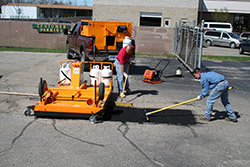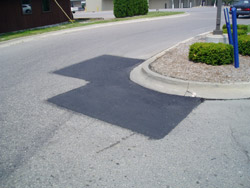The infrared process uses an infrared heating unit to heat in-place asphalt to soften it to a workable state, then new asphalt can be added which fuses seamlessly to the old. The most popular example of the technology is in pothole repair. As compared to the old saw cut method, where a square of damaged asphalt is cut out, removed and filled with new, the infrared method eliminates the seams that quickly ruin such patches. Thus, the big advantage is the feathered joining of the new patch material to the surrounding pavement – no seams, no water infiltration. Saw cut seams permit rainfall to enter, which quickly introduces moisture and freeze/thaw damage into the patch. Many such patches have to be redone every year.
 The actual step-by-step process for pothole repair using a truck-mounted infrared pavement heater is:
The actual step-by-step process for pothole repair using a truck-mounted infrared pavement heater is:
• Sweep and dry the area.
• Position the infrared heating array over the pothole for seven to 10 minutes.
• Remove the heater and rake the softened (350 degree) asphalt.
• Mix in a rejuvenator to replenish light oils that have oxidized away.
• Add a small amount of fresh asphalt and grade it to level with a lute.
• Use a vibratory roller to compact and fuse the patch with the surrounding pavement.
• Patched area is ready for traffic within 20 minutes or so (depending on size).
 The time for using old, cheap methods that fail every year is past. It is no longer acceptable to the driving public, or to transportation authorities to use flimsy repairs, ignoring things like asset management, sustainability, carbon emissions, noise pollution, recycling potential, highway safety or employee safety. Infrared addresses all these issues and others, like quality assurance and even attractive results. The process recycles the asphalt in place. In a small, unscientific random sampling of specification sheets for various departments of transportation, only a tiny percentage mention infrared jobs, and many don’t appear to use it at all.
The time for using old, cheap methods that fail every year is past. It is no longer acceptable to the driving public, or to transportation authorities to use flimsy repairs, ignoring things like asset management, sustainability, carbon emissions, noise pollution, recycling potential, highway safety or employee safety. Infrared addresses all these issues and others, like quality assurance and even attractive results. The process recycles the asphalt in place. In a small, unscientific random sampling of specification sheets for various departments of transportation, only a tiny percentage mention infrared jobs, and many don’t appear to use it at all.
Why don’t authorities specify infrared projects? Some say that while they don’t specify it, some of their larger contractors just take the initiative to use it to complete projects as they see fit, while a handful of others have purchased their own infrared systems and keep their own crews busy with infrared. Each contractor must research the attitude of local authorities in his area to find out if there is potential to increase the use of infrared repairs. Infrared may be the largest untapped opportunity for small contractors to significantly expand their business
 It’s true; the asphalt industry is inherently conservative. The long-term demand of asphalt roads, bridges, parking lots, driveways to last a long time, combined with the long time frames required to verify results, puts pressure on the industry to relentlessly test new concepts and approach new technology with caution. No doubt there is still a great deal of misunderstanding about the infrared process among contractors as well as specifying authorities. For example, as recently as 2004, the Federal Highway Administration recommends using an open flame propane torch to prepare asphalt pavement for thermoplastic signage and markings. Even the web site of AASHTO, whose members are officials of all 50 states’ highway departments, shows zero results for a search of “infrared.”
It’s true; the asphalt industry is inherently conservative. The long-term demand of asphalt roads, bridges, parking lots, driveways to last a long time, combined with the long time frames required to verify results, puts pressure on the industry to relentlessly test new concepts and approach new technology with caution. No doubt there is still a great deal of misunderstanding about the infrared process among contractors as well as specifying authorities. For example, as recently as 2004, the Federal Highway Administration recommends using an open flame propane torch to prepare asphalt pavement for thermoplastic signage and markings. Even the web site of AASHTO, whose members are officials of all 50 states’ highway departments, shows zero results for a search of “infrared.”
When it comes to driveway and parking lot contractors, the advantages of infrared are in cost savings and delivering superior results to facility managers and homeowners. For example, infrared heat is the ideal process to use for mating driveways to garage entrances, controlling smoothness and proper drainage.
Probably the most exciting uses of the infrared process are found in asphalt stamping and patterned surfaces, as well as the application of thermoplastics for decorative projects. There is no question that this market segment is on the move, making it ideal for the small contractor.
Utility work is made for infrared processes. Utility joint repairs, manholes, tricky drainage areas, high spots, catch basins, grade control – all these types of custom work that are out of the range of the big paving trains are perfect candidates for infrared treatment. It requires the intentional effort of all involved parties to raise the profile of infrared asphalt repair. Manufacturers, paving professionals and satisfied customers alike need to actively spread the word about the advantages of infrared technology. In fact, there are more than 70 demonstration videos posted on http://www.youtube.com when you enter the search term “infrared asphalt.”
Photographs were kindly submitted by Cliff Cameron of KM International. You can visit their website at www.kminb.com.



